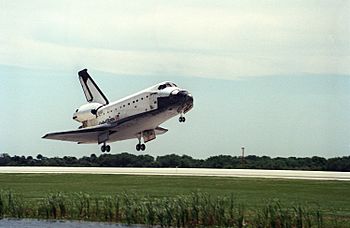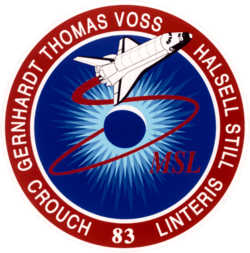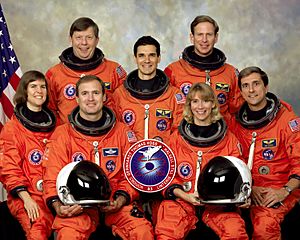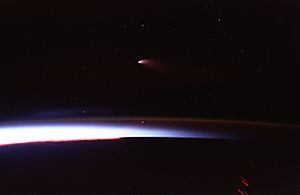STS-83 facts for kids

Columbia lands at Kennedy, following an abort of the mission due to a fuel cell malfunction
|
|
| Mission type | Microgravity research |
|---|---|
| Operator | NASA |
| Mission duration | 3 days, 23 hours, 13 minutes, 38 seconds (Planned for 15 days and 16 hours) |
| Distance travelled | 2,400,000 kilometres (1,500,000 mi) |
| Spacecraft properties | |
| Spacecraft | Space Shuttle Columbia |
| Launch mass | 117,546 kilograms (259,144 lb) |
| Landing mass | 106,724 kilograms (235,286 lb) |
| Payload mass | 11,377 kilograms (25,082 lb) |
| Crew | |
| Crew size | 7 |
| Members |
|
| Start of mission | |
| Launch date | 4 April 1997, 19:20:32.074 UTC |
| Launch site | Kennedy LC-39A |
| End of mission | |
| Landing date | 8 April 1997, 18:33 UTC |
| Landing site | Kennedy SLF Runway 33 |
| Orbital parameters | |
| Reference system | Geocentric |
| Regime | Low Earth |
| Perigee | 298 kilometres (185 mi) |
| Apogee | 302 kilometres (188 mi) |
| Inclination | 28.45 degrees |
| Period | 90.5 min |
  Left to right – Front row: Voss, Halsell, Still, Thomas; Back row: Crouch, Linteris, Gernhardt |
|
STS-83 was a NASA Space Shuttle mission. The Columbia spacecraft flew this mission. It was meant to be a science research trip into space. Even though it reached orbit, the mission ended early. A technical problem with a fuel cell caused the mission to be cut short. Instead of staying for 15 days, Columbia came back to Earth in just under four days. The same crew later flew the mission again as STS-94.
Contents
Meet the Astronauts: The STS-83 Crew
| Position | Astronaut | |
|---|---|---|
| Commander | James D. Halsell Third spaceflight |
|
| Pilot | Susan L. Still First spaceflight |
|
| Mission Specialist 1 | Janice E. Voss Third spaceflight |
|
| Mission Specialist 2 | Michael L. Gernhardt Second spaceflight |
|
| Mission Specialist 3 | Donald A. Thomas Third spaceflight |
|
| Payload Specialist 1 | Roger Crouch First spaceflight |
|
| Payload Specialist 2 | Greg Linteris First spaceflight |
|
The crew for STS-83 included seven astronauts. Each person had a special role. The Commander leads the mission. The Pilot helps fly the shuttle. Mission Specialists manage experiments and spacewalks. Payload Specialists are scientists who focus on the experiments being carried out.
Mission Overview: What Happened on STS-83?
The STS-83 mission launched on April 4, 1997. It was supposed to stay in orbit for about 15 and a half days. However, the mission ended early because of a problem with one of the shuttle's fuel cells. The fuel cell helps create electricity for the spacecraft. Because of this issue, Columbia landed on April 8, after only about four days in space.
NASA decided to fly this mission again. They called the new mission STS-94. It launched on July 1, 1997, with the same crew. This was a very unusual decision in space history.
Microgravity Science Lab: Experiments in Space
The main part of STS-83 was the Microgravity Science Laboratory (MSL). This was a set of experiments designed to study how things behave in microgravity. Microgravity is the feeling of weightlessness in space. These experiments were held inside a special European Spacelab module.
The MSL mission built on lessons from earlier space lab missions. These included missions like IML-1, USML-1, and Spacelab-J. Scientists wanted to learn more about how materials and flames act without Earth's gravity.
Key Experiments and Facilities
The MSL had 19 different science experiments. They focused on materials science. These experiments used four main facilities. One was the Large Isothermal Furnace. Another was the EXpedite the Processing of Experiments to the Space Station (EXPRESS) Rack. There was also the Electromagnetic Containerless Processing Facility (TEMPUS). Finally, the Coarsening in Solid–Liquid Mixtures (CSLM) facility, the Droplet Combustion Experiment (DCE), and the Combustion Module-1 Facility were used.
The Large Isothermal Furnace was built by the Japanese Space Agency (NASDA). It was used to study how different materials mix and move when heated. For example, it looked at how liquids and metals behave.
The Combustion Module-1 (CM-1) studied how flames work in space. One experiment looked at how soot forms in flames. Another studied tiny flame balls.
The Droplet Combustion Experiment (DCE) focused on single drops of fuel burning in microgravity. Scientists wanted to see how different pressures and oxygen levels affected the burning. This helped them understand fire safety in space.
The EXPRESS rack was a test version of equipment that would be used on the Space Station. It held experiments like the Physics of Hard Spheres (PHaSE).
The TEMPUS facility was used to study materials without touching them. This was important for very hot or delicate materials. It helped scientists learn about how metals cool and form.
Scientists also measured microgravity itself. They used tools like the Space Acceleration Measurement System (SAMS). These tools helped them understand the tiny forces acting on the shuttle.
The Middeck Glovebox (MGBX) was a sealed area for experiments. It allowed astronauts to work with samples safely. Experiments here looked at how bubbles and drops behave in space. They also studied how heat moves in microgravity.

The Reflight: STS-94 Mission
Before and during the STS-83 mission, flight controllers on Earth watched a problem. It was with Fuel Cell #2. The shuttle has three fuel cells that make power. This fuel cell seemed to have oxygen and hydrogen mixing in a way that could be dangerous. This was similar to a problem that caused an explosion on Apollo 13.
Even after trying to fix it, the problem got worse. NASA has strict "Flight Rules" for astronaut safety. These rules said that if a fuel cell crossed a certain voltage limit, it had to be shut down. If only two fuel cells were working, another rule said the mission had to end early. This was because losing a second fuel cell would make the mission very dangerous.
Astronaut Chris Hadfield was the CAPCOM for STS-83. He was the person who talked to the astronauts from mission control. He said that NASA's decision to end the mission early was a great example of using Flight Rules to keep astronauts safe. He explained that these rules help make tough decisions clear.
After Columbia landed, mission managers made a big decision. They decided to re-fly the exact same mission. This had never been done before. The shuttle went through normal checks and refills. The same crew flew the reflight, which was called STS-94. It launched just three months later, in July 1997. The mission patch was even updated. The red border changed to blue, and the number changed from 83 to 94.

